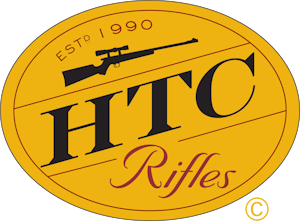When I first met Rich Reiley he told me that he was manufacturing and installing a muzzle brake that really worked. A local gunsmith, Dick Gish, started the development on this brake; with Rich doing the drawing and putting the final touches on. Dick said he got the idea from the brakes used by the military on their artillery pieces. I am not inexperienced in the area of firearms, quite the contrary, and I have used muzzle brakes in the past and I considered them to be all about the same. They vent off some of the gases perpendicular to the line of recoil to reduce recoil. But as a trade-off they really hurt your ears! They are very noisy!!
Rich informed me that not only does the High Tech Brake substantially reduce recoil, more than other brakes, but also it increases muzzle velocity and accuracy. He went on to say that this brake is built onto the weapon, not taken out of a box and the weapon made to fit the brake. This means that the brake is of the same taper and/or diameter as the barrel of the firearm it is installed on. He showed me his Remington Mountain Rifle with this brake and I was impressed with the quality and workmanship. When I found out the cost l was even more impressed.
I had the High Tech Brake installed on two Winchester Model 70's, a 30-06 and 338 Win Mag. When I received them from Rich I noted the same high quality workmanship on my rifles as he had done on his own. This tells me the man cares and takes pride in his work. The real proof is in the putting, in this case, the putting of the rifle to the shoulder. Well, I am here to tell you that I was very impressed, and I am a very critical person who is not easily impressed!! Not only was the recoil reduced, but it was drastically reduced. And unlike the KDF brake I have on my 35 Whelen, the muzzle blast (noise) did not appear to have increased! Noise is the single most stated reason for shooters to not want a brake on their firearm.
I have a dominant left eye so I shoot long guns left handed and have been shooting right handed bolt action rifles my entire life and could see no reason to change. Well, I fired a lefthanded rifle of a friend and was won over. l bought two left-handed Stainless Stalkers, 270 Win and a 338 Win Mag. I most definitely wanted the High Tech Brake on them but I saw an opportunity to prove or disprove the claims that the High Tech Brake increases velocity, increases accuracy, and is not very noisy. I tested both rifles for muzzle velocity and accuracy before the brakes were installed and after the brakes were installed. I tested these two rifles and the 30-06 I had the brake installed on earlier for the noise at the shooters ear with and without the brake in place. You will be amazed at the results of the tests. I was ... When you read these test results you will see that, in this case, "You can have your cake and eat it too." When you factor in the
cost, it is truly unbelievable!!
Velocity and Accuracy Test:
Equipment: Two new Browning Stainless Stalker Rifles, one in .270 Winchester with a 22 inch barrel and one in .338 Winchester Magnum with a 26 inch barrel. Both rifles were scoped with Leupold VXII 2x7 Matte scopes on Leupold bases and low rings. Both rifles were broken in with a shooting/cleaning/Tetragun treatment process. A Pact Professional Chronograph was used to record the velocities and compute information. The targets used were the High Tech "Red X" targets developed by Rich Reiley. The ammunition was all hand loaded using new brass that was sized, trimmed, chamfered, the flash holes deburred and the primer pockets uniformed. The bullets were alt Barnes "X", which is why the break-in and cleaning process is so critical. The primers were CCI BR-2 Bench rest primers from the same lot. The powders used were IMR, Hodgen, and Winchester and of the same respective lots. The powder was measured to the nearest I /10 of a grain by a Dillon digital scale. Ten rounds of ammo were loaded at the same setting, five rounds for use before and five rounds for after the brake was installed. Five separate loads for each rifle were used. This is 50 rounds per rifle, a total of 100 rounds for this velocity and accuracy test. I used the Hoppe's Expert Bench Rest and the respective rest bags filled with #8 lead shot, to shoot from the bench.
Conditions:
The temperatures range from 45 to 60 degrees F. The wind here never stops blowing so I had to pick days when the wind would slow to 15mph or less to shoot. In all fairness to the accuracy portion of the test, I must say that the shooting was conducted in less than ideal conditions. The wind conditions were worse for the second half of the test, when the brakes were tested.
All shooting was done from the bench, and targets were placed a measured l 00 yards from the bench. The chronograph was placed 10 feet in front of the muzzle.
Test Results:
.270 Winchester: The average velocity without the brake was 3,0 l 4.48fps. This is the average of all five loads fired. After Rich Reiley installed the High Tech Muzzle Brake, the average velocity was 3,054.20fps. This shows an average increase of39.72fps when the brake is added. This brake was added to the 22-inch barrel making the barrel slightly more that 23 inches total. The average group size without the brake was 1 .4 7 inches and the average group size after the
brake was installed was 1.56 inches. This is a .09 inch increase after the brake was installed. As stated earlier, the conditions for accuracy testing were less than ideal so I would say that that one is too close to call.
.338 Winchester Mag: The average velocity without the brake was 3,058.10. After the barrel was shortened 1 inch and the High Tech Muzzle Brake installed, the average velocity was 3,038.76. This would indicate that even after removing I inch from the barrel, the velocity is only reduced by l 9.34fps. The average group size without the brake was 3.25 inches. After the High Tech Brake was installed, the average group size was 2.32 inches. The addition of the brake reduced the group size by .93 inches.
Conclusion:
The High Tech Brake does increase muzzle velocity. The bullet is still accelerating while it is in the brake. If you take an inch off the barrel of a belted magnum you can generally figure you will lose between 50 and I 00fps depending on the load, but the loss in the .338 was only 19.34fps. The velocity gain of 39. 72fps in the .270 speaks for itself. The accuracy increase over an average of all groups fired in both calibers was .42 inches. Even if the less than ideal conditions are considered over the I 00 shots fired in this test I think this does show that the High Tech Muzzle Brake does increase accuracy. The winds were worse for the shooting after the brakes were installed, which should have decreased accuracy, but there was an increase in accuracy.
Noise Test:
Equipment: The test instrument used to measure the noise pressure was a GenRad, 1981 B Precision Sound Level Meter Ser# 1236 and it was placed in the Fast Response mode. Three rifles were used, the two Browning Stainless Stalkers, listed earlier, in .270 Winchester and .338 Winchester, and a Winchester Model 70 in 30-06. Without the brake installed the 270 has a 22- inch barrel, the 33 8 has a 25-inch barrel, and the 30-06 has a 21-inch barrel. The ammunition used was PMC Eldorado 130-grain factory loaded in the .270. The .338 ammo was a moderate velocity hand load using a 225-grain Barnes "X", and the 30-06 ammo was a high velocity hunting hand load using a 165 grain Barnes "X".
Conditions:
The test was conducted by a Colorado State Certified Audiometric Technician not affiliated to High Tech or Precision Ballistics. I did the actual firing of the rifles while the technician stood behind and to my left and measured the sound pressure at my left ear. Three shots were fired with each rifle with and without the High Tech Muzzle Brake installed. The Ambient (S.L.R.) noise level was 48.7 dBA.
Results:
The highest level recorded was I 16.2 dBA. This was the 30-06 without the brake installed. The lowest level recorded was 113 .5 dBA. This was the .33 8 without the muzzle brake installed.
The average of all nine shots fired with the muzzle brakes installed was 114.86 dBA and without the brake the average was 114.49dBA. This shows that there is literally no difference in the noise pressure levels with or without the High Tech Muzzle Brake installed. He explained that the instrument margin of error is .50 dBA, and the human ear cannot notice a change in sound pressure unless it exceeds .8 dBA. A 2-dBA increase is considered a "substantial" increase. Because sound pressure is measured on a logarithmic scale, it takes l O dBA to double the sound pressure level.
Conclusions:
The High Tech Muzzle Brake developed by Dick Gish and Rich Reiley; manufactured and installed by Rich Reiley works!! The only claim that is made by High Tech that I could not measure with a "number" is recoil. I can tell you that my 35 Whelen shooting a 225 grain bullet at 2600 fps in a Remington 700 with a KDF muzzle brake installed has more felt recoil and is considerably noisier than my 338 Winchester Magnum shooting a 225 grain bullet at 2960 fps in the lighter Browning Stainless Stalker. The .338 uses about I 6 grains more powder than the 35 Whelen does. This would indicate to me that the High Tech Brake does a much better job at lessening recoil than the KDF does, and it does not increase the noise to the shooter. I would say that my .338 recoils about like a 20-gauge shotgun and my .270 recoils like a light 22-250. When you consider the benefits of the High Tech Muzzle Brake you will notice that this muzzle brake does not have the negative drawbacks of other muzzle brakes on the market today.
- It is manufactured for your fireann, not just an add-on.
- The noise level is the same with or without the brake.
- The felt recoil is reduced more than any other of the brakes I have shot, and the muzzle rise or ''FLIP' is completely eliminated.
- There is a verifiable increase in muzzle velocity when the brake is installed.
- The accuracy is increased when the brake is installed.
- You have the option of easily and quickly removing or replacing the brake.
- The cost of the brake and installation is less than any other I have priced.
- The fact that Rich Reiley and Dick Gish care about you and your firearm means that you can expect and will receive first rate workmanship and service from them, as I did.
- The High Tech Brake can be made to order, as for a varmint rifle without the holes drilled in
the bottom for shooting prone in a dusty environment.
At least in the world of muzzle brakes "You can have your cake and eat it too", thanks to the High Tech Muzzle Brake.
The complete test results are available on request.
Jim Rau, Retired police officer,









